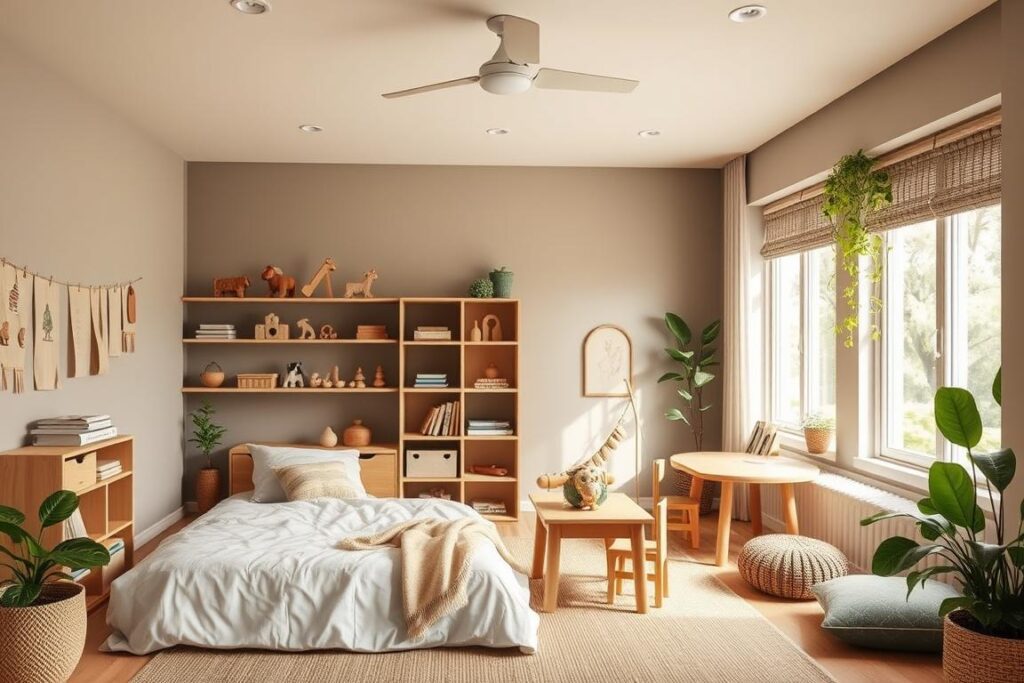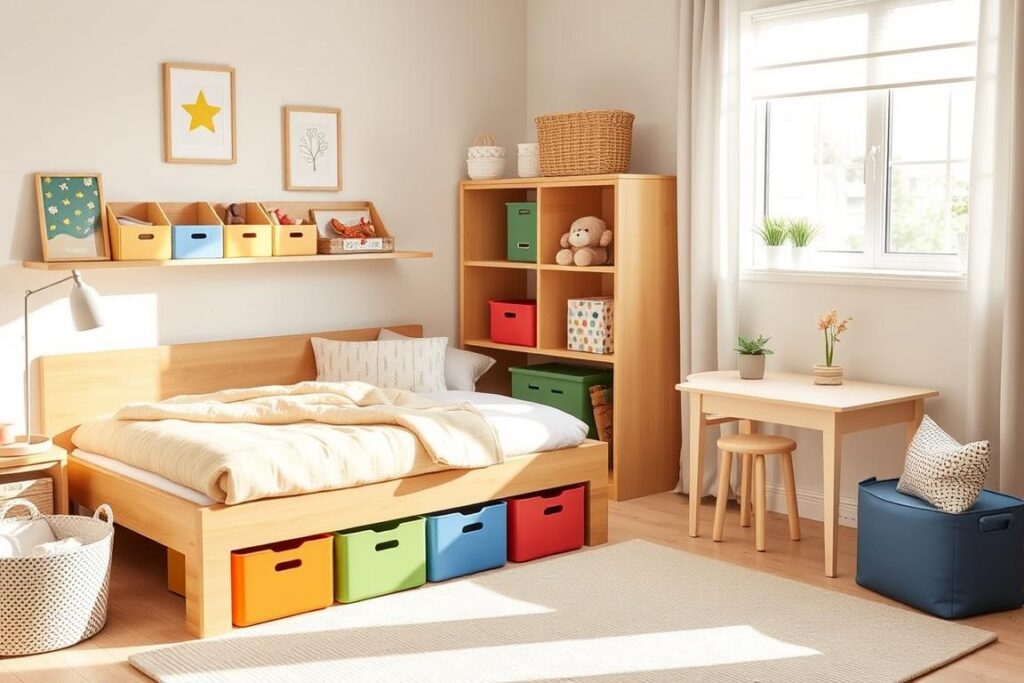Our son is growing up fast, and it’s time to change his nursery into a Montessori bedroom. This change shows he’s becoming more independent. We want his room to spark his curiosity and help him learn on his own.
The Montessori way focuses on a space that’s all about the child. It should let him move freely, have the right tools, and learn important life skills. We’re excited to make his room a place that supports his growth and helps him become more self-sufficient.
Key Takeaways
- Transitioning a nursery into a Montessori-inspired “big boy room” supports a child’s growing independence and developmental needs.
- Incorporating Montessori principles in the bedroom design creates an environment that nurtures curiosity, encourages self-directed exploration, and fosters practical life skills.
- The Montessori approach emphasizes a child-centric space with freedom of movement, access to age-appropriate materials, and the cultivation of practical life skills.
- Transforming the nursery into a welcoming and organized “big boy room” supports the child’s holistic growth and development.
- Careful planning and attention to safety considerations are crucial during the transition process.
Understanding Montessori Principles in Bedroom Design
Designing a child’s bedroom with Montessori principles is key. This method focuses on a child-centered space. It promotes independence, self-learning, and respect for the child’s growth.
Key Elements of a Montessori Environment
A Montessori bedroom should have certain elements. It should have learning materials that fit the child’s age and are easy to reach. There should also be areas for different activities and furniture that helps the child be independent, like low shelves and small tables and chairs.
Child-Centered Space Planning
The room’s layout should meet the child’s needs. Place things they use often within reach. Make sure there are areas for play and exploration, and keep the room tidy. This lets the child move freely and feel confident.
Independence-Promoting Features
- Low, accessible shelves for storing toys and learning materials
- Child-sized furniture, such as a floor bed, small table, and chairs
- Readily available self-care items, like a step stool and child-height mirror
- Clearly defined activity areas for play, reading, and creative expression
By using Montessori principles in bedroom design, parents can create a space that encourages curiosity and independence. It supports the child’s overall growth.
Planning the Transition Timeline from Nursery
Changing your child’s room from a nursery to a “big boy room” is exciting but can feel overwhelming. With good planning, you can make the transition smooth. This sets the stage for your child’s growth and independence. A well-thought-out timeline is key, considering your child’s development, likes, and the practical steps of the change.
Timing is everything when moving from a nursery to a toddler room. Experts say start around your child’s second birthday. This is a big milestone when they’re ready for a more independent space. This age allows for a gradual change that’s exciting for your child.
- Involve your child in planning. Let them share their ideas and what they like. This makes them feel part of the process and more excited about the change.
- Make small changes first. Start with updates and new items that slowly change the room. This could be swapping out nursery decor for something more suitable, adding new furniture, or rearranging the room.
- Keep asking your child for their thoughts and ideas. This ensures the room reflects their interests and personality. It also makes them feel empowered and involved.
By planning well, you can make the transition from nursery to toddler room exciting and smooth. Involve your child, make changes gradually, and keep them excited and involved in the makeover.
“The way we design a child’s room can have a profound impact on their development and well-being. By incorporating Montessori principles, we can create a space that nurtures independence, exploration, and a love for learning.” – Maria Montessori
Essential Safety Considerations for Toddler Rooms
Creating a safe space for your toddler is key when setting up their “big boy room.” We must focus on childproofing, anchoring furniture, and choosing safe materials. This ensures a safe and nurturing environment for your child.
Childproofing Measures
Childproofing your toddler’s room is a detailed task. First, cover all electrical outlets. Install safety gates at doors to stop wandering. Use corner guards on furniture and window guards to prevent falls.
Also, add child-proof locks on cabinets and drawers. This keeps curious hands away from dangers.
Furniture Anchoring Guidelines
Securing furniture is vital for toddler room safety. Anchor dressers, bookcases, and tall furniture to walls. This prevents tip-overs, which can be dangerous.
Choose furniture with rounded edges. Opt for low-profile designs to reduce accident risks.
Safe Material Choices
The materials in your toddler’s room should be safe, durable, and easy to clean. Pick fabrics, rugs, and decor without harmful chemicals or flame-retardants. Go for natural, breathable materials that are safe for your child.
By focusing on these safety measures, you can make a room that’s both safe and lovely. Your child can explore and grow in a secure space.
Choosing the Perfect “Big Boy Room” Furniture
When your toddler moves from a nursery to a “big boy room,” picking the right furniture is key. Focus on toddler furniture and child-sized furnishings that help them grow independent and function well.
For Montessori bedroom furniture, pick items that fit your child’s size. Look for low, strong dressers and nightstands they can reach by themselves. A floor bed or a low bed is best for easy getting in and out.
- Invest in a small, child-sized desk and chair set for quiet play and learning activities.
- Incorporate a low bookshelf or open storage units to display their favorite books and toys.
- Choose simple, natural-toned pieces that blend harmoniously with the Montessori aesthetic.
The aim is to make a space that lets your child feel in charge. By picking the right toddler furniture and child-sized furnishings, you help them grow and play confidently in their “big boy room.”
“The environment must be rich in motives which lend interest to activity and invite the child to conduct his own experiences.”
– Maria Montessori
Floor Bed vs Traditional Bed: Making the Right Choice
Choosing between a floor bed and a traditional bed is key in a Montessori-inspired toddler bedroom. Knowing the perks of a Montessori floor bed helps you pick the best option. This choice should match your child’s needs and the Montessori philosophy.
Benefits of Floor Beds
- Promotes Independence: A floor bed lets your child get in and out on their own. This boosts their sense of self and independence.
- Accessibility and Comfort: It’s easy for your toddler to get to their bed. This makes their sleeping area both comfy and safe.
- Safer Transitions: The low height of a floor bed lowers the risk of falls and injuries. This is especially important in the early years.
- Encourages Exploration: A floor bed lets your child move around freely. This sparks their curiosity and encourages exploration.
Mattress Selection Tips
Choosing the right mattress for a Montessori floor bed is crucial. Look for a high-quality, firm mattress that supports your child’s spine. Avoid soft mattresses that could be a suffocation risk. Also, pick a mattress size that fits your child’s sleeping area well.
| Mattress Attributes | Recommended Features |
|---|---|
| Firmness | Medium-firm to firm |
| Material | Organic, natural fibers (e.g., wool, cotton, or latex) |
| Thickness | 4-6 inches |
| Size | Twin or Twin XL |
By understanding the benefits of a Montessori floor bed and picking the right mattress, you can create a safe and cozy sleep space for your toddler.
Creating Accessible Storage Solutions
Organizing a toddler’s room is key. Montessori ideas focus on making storage easy and accessible. This lets young kids help keep their space tidy. It’s a great way to encourage their curiosity and independence.
Use low-level shelves or cubbies that kids can reach. This lets them put things away by themselves. It teaches them to be responsible and proud of their space. Clear bins or baskets are good for storing things because they’re easy to see into.
| Storage Solution | Benefit |
|---|---|
| Low-level shelves | Encourages independence and self-care |
| Clear plastic bins | Visibility promotes easy identification and access |
| Labeled storage containers | Fosters organization and self-management skills |
Labeling storage with pictures or words helps kids learn to organize. It makes cleaning up easier and more fun. It shows them that a tidy space is inviting.
These tips help make a room that’s safe and fun for kids. It’s a place where they can grow and learn. Good storage is essential for a Montessori bedroom.
Implementing Child-Height Learning Areas
Designing a Montessori-inspired bedroom for your toddler is key. It’s important to make learning spaces at their eye level. This encourages them to explore and love learning early on.
Reading Nooks Design
Create a cozy reading nook for your child. Use low shelves to display their books. Add a plush cushion or a small chair for comfort.
Make sure the lighting is soft and calm. This helps create a peaceful spot for reading.
Activity Zones Setup
Set up different areas for Montessori activities. You might have a low art table, a sensory station, or a building area. These activity zones for kids let them try new things and learn at their own speed.
The heart of Montessori learning spaces is independence, curiosity, and ownership. Designing a toddler’s room with these in mind helps their growth and love for learning.
Selecting Age-Appropriate Decor and Colors
Choosing the right decor and colors is key for a Montessori-inspired toddler room. It helps create a calm and engaging space. The right toddler room decor and calming colors for kids’ rooms boost learning and growth. They follow the Montessori-inspired design principles.
Montessori design focuses on natural and organic materials. Use natural wood, soft fabrics, and earthy colors for a soothing feel. Stay away from bright or busy designs, as they can confuse young children.
- Choose calming colors like soft blues, greens, and neutrals for peace and focus.
- Go for natural wood furniture and decor to match the Montessori way.
- Add textures like woven baskets, linen curtains, and natural fiber rugs for interest.
The aim is to make a space that looks good and helps your child grow. By picking the right toddler room decor and calming colors for kids’ rooms, you create a Montessori-inspired area. This area encourages independence, exploration, and well-being.
“The environment must be rich in motives which lend interest to activity and invite the child to conduct his own experiences.”
– Maria Montessori
Organizing Toys and Learning Materials
As parents, we know how key it is to keep our kids’ spaces tidy. In a Montessori bedroom, this is even more important. It helps our children grow in a clean, organized place that encourages them to be independent and learn new skills. A good way to do this is by using a toy rotation system and arranging Montessori materials thoughtfully.
Rotation System Setup
The toy rotation system is a smart way to handle the many toys and learning tools our kids have. By switching out a few items at a time, we keep our child from getting overwhelmed. Here’s how to set up a good rotation system:
- Choose toys and materials that match your child’s interests and needs.
- Split the collection into three or four groups. Each group should have different activities.
- Switch the groups every few weeks to keep things fresh and exciting for your child.
- Keep the groups not being used out of sight but still easy to find, to avoid mess and too much stimulation.
Practical Life Materials Display
Montessori practical life materials help our toddlers become independent and learn important life skills. By showing these materials in a neat and easy-to-reach way, we spark their curiosity and love for learning. Here are some tips:
- Use low shelves or trays to make the materials easy for your child to get to.
- Organize the materials in a clear and logical way, grouping similar items together.
- Make sure each item is clean, complete, and in good shape to teach your child about care and respect.
- Change out the practical life materials now and then to keep things interesting and new.
By using a toy rotation system and arranging Montessori materials with care, you can make a space that helps your child grow, be independent, and keeps your “big boy room” tidy.
Lighting Design for Comfort and Function
Creating the ideal toddler room involves careful lighting design. It’s important to find the right mix of natural toddler room lighting and artificial light. This balance makes the room both beautiful and practical for a growing child.
Natural light in kids’ rooms adds warmth and openness. It also aligns with the Montessori idea of connecting with nature. Placing windows and skylights right can bring in lots of daylight. This makes the room calm and engaging all day long.
Night lights for children are key for a safe and cozy space at night. Soft, adjustable lights help toddlers feel safe and happy as they learn to sleep alone in their “big boy room.”
| Lighting Consideration | Importance | Recommended Solution |
|---|---|---|
| Natural Light | Enhances mood, supports Montessori principles | Large windows, skylights |
| Task Lighting | Illuminates play and learning areas | Adjustable desk lamps, floor lamps |
| Ambient Lighting | Creates a cozy, soothing atmosphere | Dimmable ceiling fixtures, wall sconces |
| Night Lights | Provides comfort and safety during the night | Motion-activated, soft-glow night lights |
By carefully designing the lighting in a toddler’s room, parents can make a space that looks good and supports a child’s growth and happiness.
“Lighting is a key element in creating a Montessori-inspired environment, as it should be soft, natural, and indirect to foster a sense of calm and exploration.”
Maintaining Order and Teaching Room Care
Keeping a big boy room tidy is key for your child’s comfort and focus. It also helps them feel responsible. By teaching your toddler to clean, you’re teaching them valuable Montessori habits. These habits help them appreciate order and care for their space.
Begin by teaching your child to clean up their toys and books every day. Give them small cleaning tools, like a tiny broom or dustpan. Show them how to use these tools and praise their efforts. This helps them feel proud of their clean space and teaches them important toddler room maintenance skills.
Make teaching tidying skills a part of your child’s daily routine. Let them help with watering plants, wiping tables, or organizing their things. This builds their independence and sense of responsibility. By showing them how to clean, you’re teaching them to take care of their “big boy room” and develop good organizational habits.
FAQ
What are the key elements of a Montessori environment for a toddler’s bedroom?
A Montessori-inspired toddler’s bedroom focuses on the child. It has a space that encourages independence. The room has furniture and materials that help the child grow and learn.
How do I plan the transition timeline from a nursery to a “big boy room”?
Planning a smooth transition is key. Start by picking the right time. Make changes slowly. Involve your child in the process for a positive experience.
What are the essential safety considerations for designing a toddler’s room?
Childproofing is crucial for a toddler’s room. Make sure furniture is stable. Use safe materials for everything. This creates a secure space for your child.
How do I choose the perfect “big boy room” furniture that aligns with Montessori principles?
Look for furniture that’s the right size for your child. It should be functional and support their growth. This helps them learn and explore.
What are the benefits of a Montessori floor bed, and how do I choose the right mattress?
A Montessori floor bed promotes independence and natural sleep. Choose a mattress based on your child’s age, size, and comfort. This ensures a safe and cozy sleep space.
How can I create accessible storage solutions in a toddler’s room?
Use low shelves, baskets, and drawers for storage. This lets your child manage their things easily. It keeps their space organized and tidy.
How do I design child-height learning areas in the big boy room?
Create learning areas at your child’s height. This could be a cozy reading nook or activity zone. It encourages learning and supports Montessori principles.
What are the considerations for selecting age-appropriate decor and colors in a toddler’s room?
Choose decor and colors that match Montessori principles. Aim for a space that’s stimulating yet calm. This supports your child’s development and sensory needs.
How do I organize toys and learning materials in a Montessori-inspired big boy room?
Use a toy rotation system and display practical life materials. This keeps the room tidy. It also encourages your child to explore and develop new skills.
How do I design the lighting in a toddler’s room for comfort and function?
Use a mix of natural and artificial light. Night lights are helpful. This creates a comfortable and functional lighting setup for your child’s needs.
Involve your toddler in cleaning and organizing. Teach them to take care of their space. This helps keep the room tidy and teaches important life skills.








